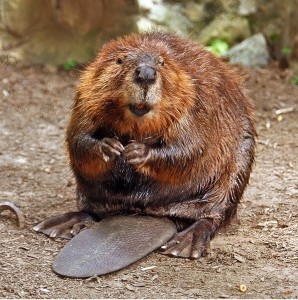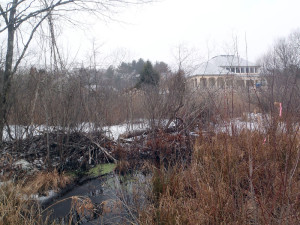New ‘neighbor’ sparks worry, excitement in Ponkapoag
By Jay TurnerThe following article originally appeared in the February 5 edition of the Canton Citizen. Click here to order your subscription today.
A new neighbor has moved into the Ponkapoag section of Canton, and it’s either a reason for celebration or a cause for alarm — or possibly both.
The new resident is a Castor canadensis, or North American beaver, and it’s the first known discovery of the species in Canton in quite some time, perhaps even hundreds of years.
Known as “nature’s engineers” for their dam and lodge building prowess, beavers, which are the second-largest rodent in the world behind the South American capybara, disappeared altogether from the state for nearly 180 years before making a comeback in the mid 20th century. The population has since been fully restored and the animal can now be found throughout much of the commonwealth; however, it is still uncommon in southeastern Massachusetts, according to the state Department of Fisheries and Wildlife.
“Pretty amazing stuff,” noted Ponkapoag resident Ed Kodzis, who initially saw signs of beaver activity in the summer and was able to locate the animal’s unmistakable print in the snow last month.
Kodzis, who had been told about a possible dam and flooding on Ponkapoag brook, said he originally suspected muskrats to be the culprit, but he began to change his mind after gathering more information.
Muskrats, for one, do not cut down trees, and last summer at the Milton Hoosic Golf Course, where Kodzis is a member, a “beautiful alder” near the ninth hole was felled by a mystery animal — the evidence apparent in the teeth marks left on the tree stump.
Kodzis also began to look into the reports of flooding in the area, and what he found was an alarming amount of water that was impacting the nearby sewer line.
In an email to the Mass. Water Resources Authority, Kodzis wrote, “It seems some beavers have done some work to plug up the brook and it is now flooding. My concern is that the flooding will get to a level where the new sewer access manholes will be covered with water. There also seems to be some erosion of the new access road as the brook has been redirected. I think it deserves a walk-through since beavers can be very destructive.”
Kodzis said MWRA officials were very responsive to his inquiry and quickly undertook an investigation, which confirmed his suspicions as well as the exact location of the beaver dam — right behind Cherokee Road.
For Kodzis, the fact that an “80-pound rodent with big teeth” is now a confirmed neighbor of his is both exciting and concerning — exciting because it is rare and he has a natural curiosity and appreciation for wildlife, but also concerning because of the damage that beavers can do.
“It was a privilege to have found it,” he said, “but I also realize that it does bring its problems.”
In particular, Kodzis said he is worried about the integrity of the sewer line, which is the responsibility of the town and services hundreds of homes, as well as the potential for flooding on nearby residential properties.
Kodzis said it could also be problematic for the Milton Hoosic, especially if the beaver decides to move further downstream, which could potentially cause flooding around the first hole.
Mark Thomas, another Ponkapoag resident and owner of a wildlife removal business, Baystate Wildlife Management Inc., was more matter-of-fact in his assessment of beavers in the neighborhood.
“Beavers are bad news,” said Thomas, who recently spotted the beaver in question near the brook. “It’s cute and cool in the beginning, but then it really becomes bad pretty quickly.”
In addition to the flooding problems, Thomas said beavers “kill all the trees” in the area and are generally more disruptive than they are beneficial — at least when they are located too close to human development.
Thomas said that beavers, if allowed to remain, would be one more wildlife problem in a neighborhood that is already dealing with more than its share, including a recent infiltration of coyotes.
“We’ve had huge problems with coyotes out there,” he said. “I have pictures of nine different coyotes all out behind my house. They have killed some of my chickens, and they’re wreaking havoc back there.”
Thomas believes that the beavers should be “trapped and removed,” which is permissible in Massachusetts between November 1 and April 15 if done by a licensed trapper. However, they are only permitted to use kill traps, as it is against state law to capture and release an animal in another location.
Not everyone has the same view of beavers as Thomas, however.
MassWildlife, for instance, suggests a number of nonlethal solutions to address human conflicts with beavers, including tolerance, fencing, dam removal, and water level control devices, or “beaver pipes,” which allows water to flow through a dam while remaining undetected by the beaver.
MassWildlife, on its beaver information webpage, also highlights many of the beneficial aspects of beavers, noting that they have played an “active role in New England ecology for thousands of years.”
According to MassWildlife, “By damming streams and forming shallow ponds, beavers create wetlands. These wetlands provide habitat for a tremendous diversity of plants, invertebrates, and wildlife, such as deer, bats, otter, herons, waterfowl, songbirds, raptors, salamanders, turtles, frogs, and fish.”
The state agency suggests that humans also benefit from beavers, as these new wetlands help to control downstream flooding, improve water quality, and can also recharge groundwater.
Ian Cooke, executive director for the Canton-based Neponset River Watershed Association, noted that beavers are also “quite good for rivers.”
“In a natural river system, they are quite beneficial from an ecological standpoint in the sense that they create wetlands, which tend to be habitats that support a lot of wildlife,” he said.
Cooke said that this was the first that he had heard of a beaver in the Neponset River watershed, although he has often wondered why he hasn’t seen them before. “They’ve certainly been in surrounding areas for quite a while,” he said. “There are plenty of beavers on the Charles and in nearby towns such as Dedham.”
And while NepRWA is currently in the process of removing small manmade dams along the watershed as part of its recently launched small dams project, Cooke stressed that natural dams are far less harmful to the river system.
“We as an organization are interested in taking out some of the small and larger dams to restore fish runs,” he said. “There is a question as to whether beaver dams impact the fish too. They could to some degree, but studies of fish passage around beaver dams have found that fish can find their way around, through, or over the dams.”
As for Kodzis, the man who got to the bottom of this neighborhood mystery, he is still undecided about how he feels about beavers. Personally, he said they do not bother him “one way or the other,” although he acknowledges that their presence may impact some more than others.
Nevertheless, Kodzis finds it “amazing” that there is so much wildlife right in his backyard.
“And if the beavers are going to be here,” he said, “then we have to learn how to live with them.”
Short URL: https://www.thecantoncitizen.com/?p=28498












